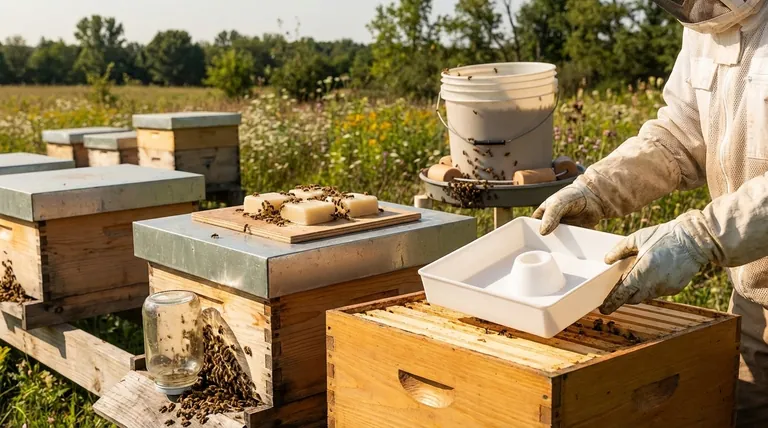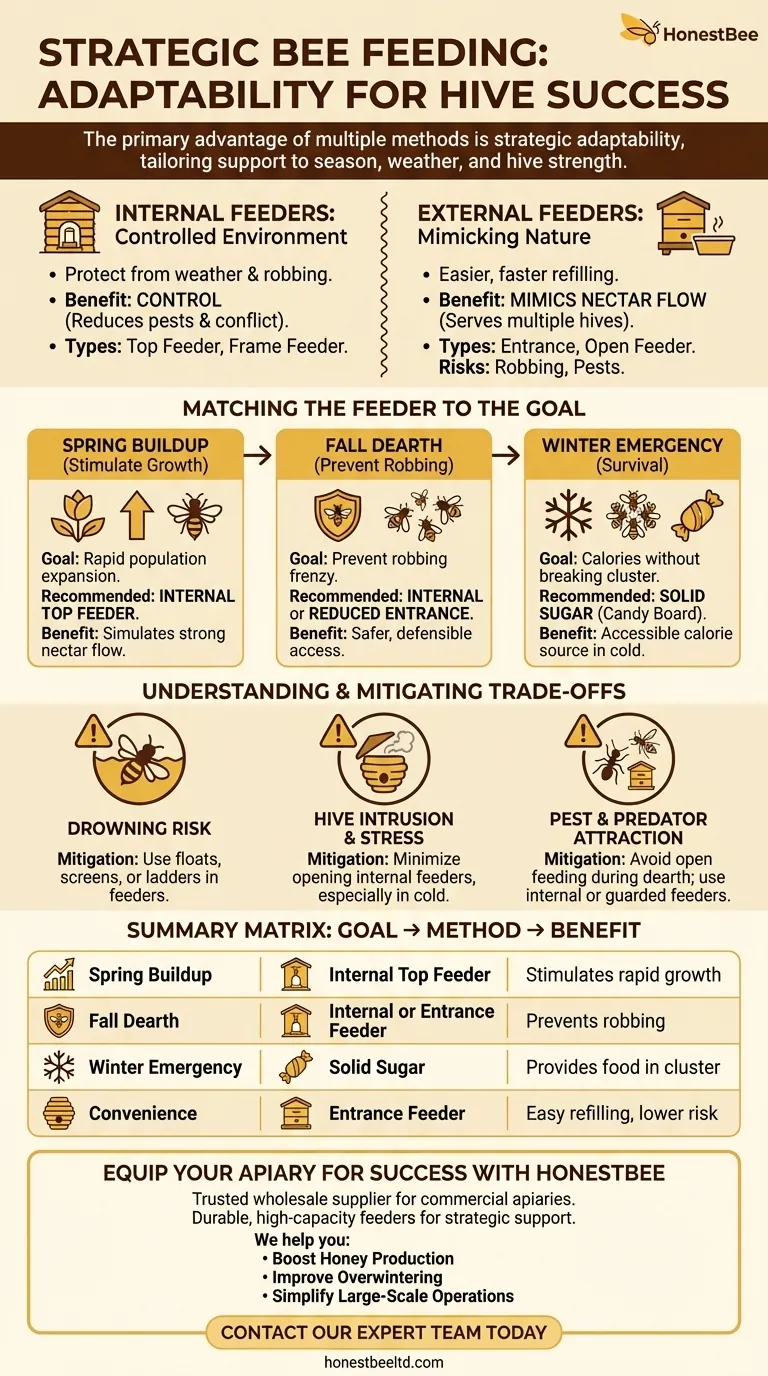The primary advantage of having multiple bee feeding methods is strategic adaptability. A beekeeper with access to different feeder types can tailor their support to the colony's precise needs, which change dramatically with the season, weather, and hive strength. This flexibility allows you to solve specific problems, from stimulating spring growth to preventing hive collapse in the winter.
The method you use to feed your bees is just as important as the food you provide. Choosing the right feeder for the season, colony strength, and your specific goal is a fundamental skill for proactive hive management.

The Core Principle: Internal vs. External Feeding
The most significant distinction between feeding methods is whether the food source is placed inside or outside the hive. Each approach serves a different strategic purpose.
Internal Feeders: A Controlled Environment
Internal feeders are placed within the confines of the hive body. This includes top feeders, frame feeders, and hive-top feeders.
Their primary benefit is control. By feeding inside, you protect the syrup from rain, cold temperatures, and other bees from neighboring hives. This significantly reduces the risk of attracting pests or inciting "robbing," where stronger hives attack and steal resources from weaker ones.
External Feeders: Mimicking Nature
External feeders are placed outside the hive. The most common types are entrance feeders (which sit at the hive entrance) and open feeders (large containers of syrup placed in the apiary for all hives to access).
These feeders are often easier and faster to refill, as they don't require opening the hive. Open feeding, in particular, can mimic a natural nectar flow and serve multiple colonies at once, but it comes with significant risks.
Matching the Feeder to the Goal
The true value of having multiple options is the ability to apply the right tool for the right job. A feeder that is perfect for spring can be dangerous in the fall.
For Stimulating Spring Buildup
In early spring, the goal is to encourage the queen to lay eggs and rapidly expand the colony's population.
An internal top feeder is ideal here. It holds a large volume of syrup directly above the brood nest, providing a consistent and easily accessible resource that simulates a strong nectar flow, signaling to the queen that it's safe to expand.
For Preventing Robbing in the Fall
During a nectar dearth in late summer or fall, colonies become highly defensive and opportunistic. An exposed food source can trigger a frenzy of robbing.
Internal feeders are the safest choice. If you must feed externally, a small entrance feeder with a reduced opening can work, as the colony's guard bees can more easily defend the small access point. Open feeding during this time is extremely risky and often leads to the destruction of weaker hives.
For Emergency Winter Feeding
Bees cannot take liquid syrup when temperatures are too cold, as breaking cluster to access it would be fatal.
For winter emergencies, the method changes entirely. Beekeepers use solid sugar, such as fondant, sugar bricks, or a "candy board," placed directly on top of the frames. This provides a calorie-dense food source the bees can access without leaving the warmth of their cluster.
Understanding the Trade-offs
No feeding method is perfect. Being an effective beekeeper means understanding the downsides of each choice and mitigating the risks.
The Risk of Drowning
Many feeder designs, especially internal top feeders or simple buckets, can pose a drowning risk to bees. It is critical to always provide floats, screens, or ladders (like wooden sticks or hardware cloth) that allow bees to access the syrup without falling in.
Hive Intrusion and Stress
While internal feeders offer more control, they require you to open the hive to check and refill them. This disturbs the colony, breaks the propolis seal, and can chill the brood, especially in cooler weather.
Pest and Predator Attraction
External feeders, particularly open feeders, are an open invitation to unwanted guests. Wasps, hornets, ants, and even raccoons will be attracted to the easy meal, creating competition and stress for your bees.
Making the Right Choice for Your Colony
Your choice of feeder should always be a conscious decision based on a clear objective. A beekeeper's toolkit should include several options to respond effectively to the colony's needs.
- If your primary focus is rapid population growth: Use a large-volume internal feeder that keeps a steady supply of syrup close to the brood nest.
- If your primary focus is preventing robbing during a nectar dearth: Rely exclusively on internal feeders or a well-guarded entrance feeder.
- If your primary focus is providing emergency winter food: Use solid sugar methods like candy boards or dry sugar placed over the inner cover.
- If your primary focus is convenience for a strong apiary: An entrance feeder is a good compromise, offering easy refilling with a lower robbing risk than open feeding.
Ultimately, a versatile approach to feeding empowers you to be a proactive beekeeper, not just a reactive one.
Summary Table:
| Goal | Recommended Feeding Method | Key Benefit |
|---|---|---|
| Spring Buildup | Internal Top Feeder | Stimulates rapid population growth |
| Fall Dearth | Internal or Entrance Feeder | Prevents robbing from other hives |
| Winter Emergency | Solid Sugar (Candy Board) | Provides food without breaking cluster |
| Convenience for Strong Hives | Entrance Feeder | Easy refilling with lower risk |
Equip your apiary for success with the right feeding solutions from HONESTBEE.
Managing a thriving apiary requires the right tools for every season. As a trusted wholesale supplier for commercial apiaries and beekeeping equipment distributors, HONESTBEE provides the durable, high-capacity feeders you need to support your colonies strategically.
We help you:
- Boost Honey Production: Ensure consistent nutrition to build strong, productive colonies.
- Improve Overwintering Success: Access the right equipment for effective winter feeding.
- Simplify Large-Scale Operations: Our wholesale-focused operations are built to support your commercial needs efficiently.
Ready to optimize your feeding strategy? Contact our expert team today to discuss your specific requirements and volume pricing.
Visual Guide

Related Products
- HONESTBEE Professional Hive Top Bee Feeder Feeding Solution
- HONESTBEE Advanced Ergonomic Stainless Steel Hive Tool for Beekeeping
- Professional Hive Top Bee Feeder for Beekeeping
- HONESTBEE Round Hive Top Bee Feeder for Syrup
- HONESTBEE Entrance Bee Feeder Professional Hive Nutrition Solution for Beekeeping
People Also Ask
- Why is a top feeder essential for bees? Ensure Colony Health and Efficiency
- What is the best way to top feed bees? A Safe, High-Volume Feeding Solution for Your Apiary
- How is the plywood floor fitted into the hive-top feeder? Ensure Longevity with a Floating Floor Design
- What safety features are included in top feeders? A Guide to Drowning Prevention and Hive Safety
- Do I need an inner cover with a hive top feeder? Optimize Your Hive Setup for Healthy Bees



















